The marquee match of the group stage featured a rematch of the 2016 Euro championship game, Portugal vs France, the European champs against the world champs.
Fresh off a shellacking at the hands of Germany, Fernando Santos went back to the drawing board in search of greater squad balance.
With Portugal unable to control the midfield, changes were needed and one of the unlikely victims was Bruno Fernandes, a player Jose Mourinho criticized in the build-up to the final group stage game.
The double pivot of Danilo and William Carvalho was another issue with neither player offering the progression of quality, efficiently stepping into midfield to provide outlets or pressure higher up the pitch.
Didier Deschamps was in an interesting place as well. Having already qualified for the Round of 16, he rotated his outside-backs and pulled Juventus midfielder Adrien Rabiot from the starting lineup. The substitutions seemed like an attempt to rotate the squad while still fielding a strong enough lineup to win the group.
The two sides entered the tournament among the favourites to claim the title and this group stage matchup was earmarked as one of the marquee games of the first phase. This tactical analysis will look at the keys to the match, especially looking at each team’s midfield. While the game was rather tame from the 75th minute on, each side seemingly signing a pact of non-aggression, second half substitutions impacted each team’s tactics and provided 30 entertaining minutes.
Lineups
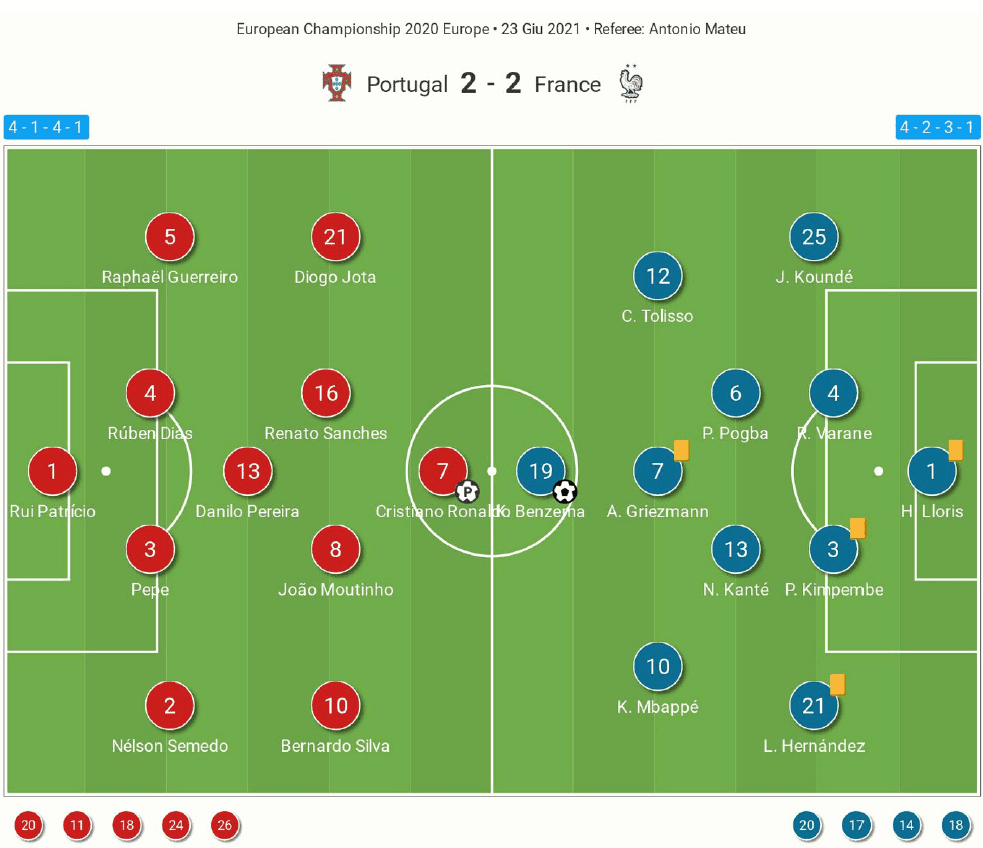
Santos set out his Portuguese in a 4-1-4-1 with Rui Patricio in goal. Despite poor performances against Germany, the backline remained the same with Nélson Semedo on the right, Raphaël Guerreiro on the left and the pair of Rúben Dias and Pepe in the middle. Danilo Pereira operated as the lone pivot with Renato Sanches and João Moutinho joining him centrally. Bernardo Silva and Diogo Jota continued to start in the wings while Cristiano Ronaldo manned the top of the formation.
For Didier Deschamps, the team sheet showed a 4-2-3-1, but it more closely resembled a 4-4-2 with a diamond midfield. Tolisso, listed as the right attacking midfielder, moved into the right half-space to connect with Paul Pogba and N’Golo Kanté in central midfield. Kylian Mbappé pushed high up the pitch with Karim Benzema while Antoine Griezmann completed a midfield diamond playing just underneath the two forwards. Jules Koundé, a centre-back for Sevilla, received the start at right-back with Lucas Hernandez starting on the left. Presnel Kimpembe and Raphaël Varane were the two centre-backs and Hugo Lloris took his place between the pipes.
Portugal finds midfield balance
Portugal’s match against Germany was a warning to Santos; fix the midfield or risk an early exit. The double pivot of Danilo and Carvalho, which had worked in previous years when the latter had better match fitness, had suddenly left Portugal vulnerable in the build-out, struggling to connect the lines and somehow failing to protect the backline. Germany consistently looked to push numbers between the Portuguese lines or skip that central block entirely with long diagonal switches to Robin Gosens. More pressure was needed higher up the pitch, as was better mobility in midfield and players who could connect the Portuguese lines.
Exit Carvalho and Fernandes, enter Sanches and Moutinho.
Whereas Carvalho and Fernandes were positionally stagnant, struggling to aid the build-out in the one case and failing to offer a high target in the other, Sanches’ energy and midfield intelligence were exactly what Portugal needed.
In the case of Sanches, as seen in the average position map below, his ability to engage higher up the pitch while still defending resolutely was the biggest difference from matchday two to three.
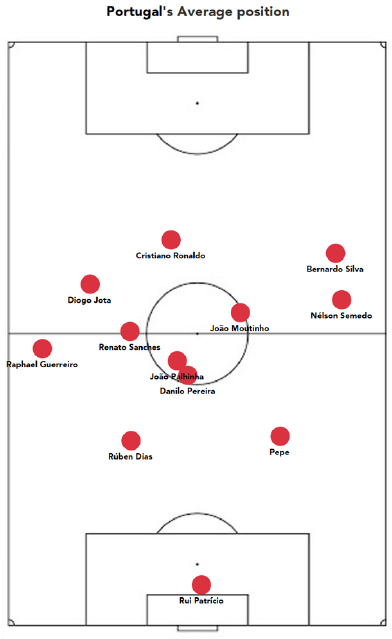
Throughout the match, Sanches showed an excellent understanding of his defensive commitments. Often starting more centrally, his read of play and fantastic physical qualities allowed him to help defend in the wings without leaving a gaping hole in the middle. The improvement in midfield mobility was critical to Portugal’s defensive work.
On the attacking side of the ball, Sanches was a difference-maker for the Portuguese. His work in transition was especially dynamic. In the image below, he moved from his starting position in the left half space into the wing as Benzema received the pass. As the Frenchman cut the ball back away from the challenge of Jota, Sanches read the play brilliantly and won the tackle. With space to run, Sanches took off, leading the Portuguese counterattack.
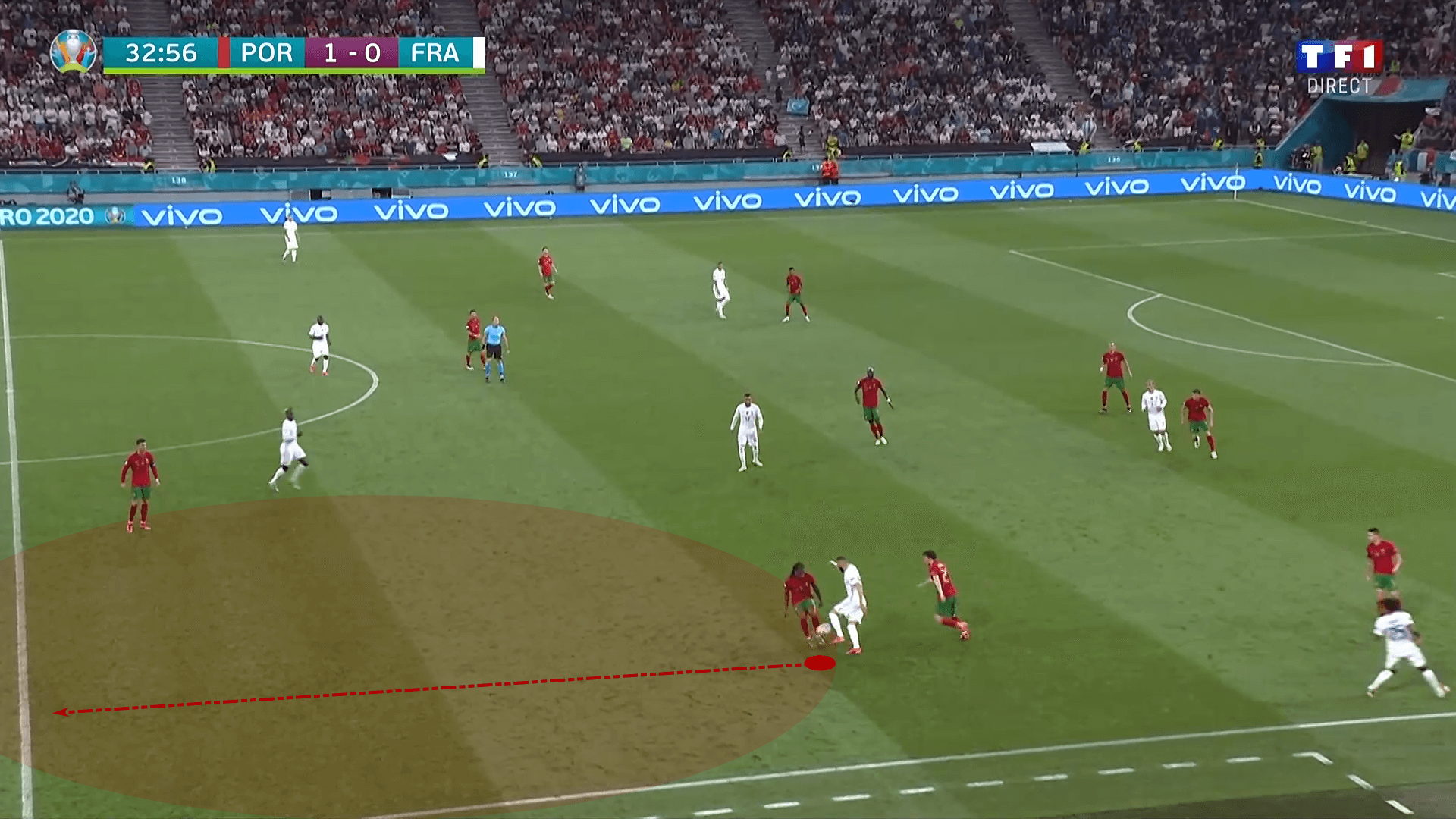
His transitional attacking offered far more than William had in the previous two matches. While William is a quality distributor, Sanches’ ability to progress the attack through either the dribble or pass made the team much more dynamic.
Further, in open play, Sanches’s strength on the ball allowed him to hold off challenges from Tolisso, Pogba and Kanté with ease. The French struggled to contain the 23-year-old Lille midfielder. He was so effective in possession that France routinely became unbalanced near the ball when he was in possession. Sanches’ ability to hold up play and draw the French towards him created space for his teammates.
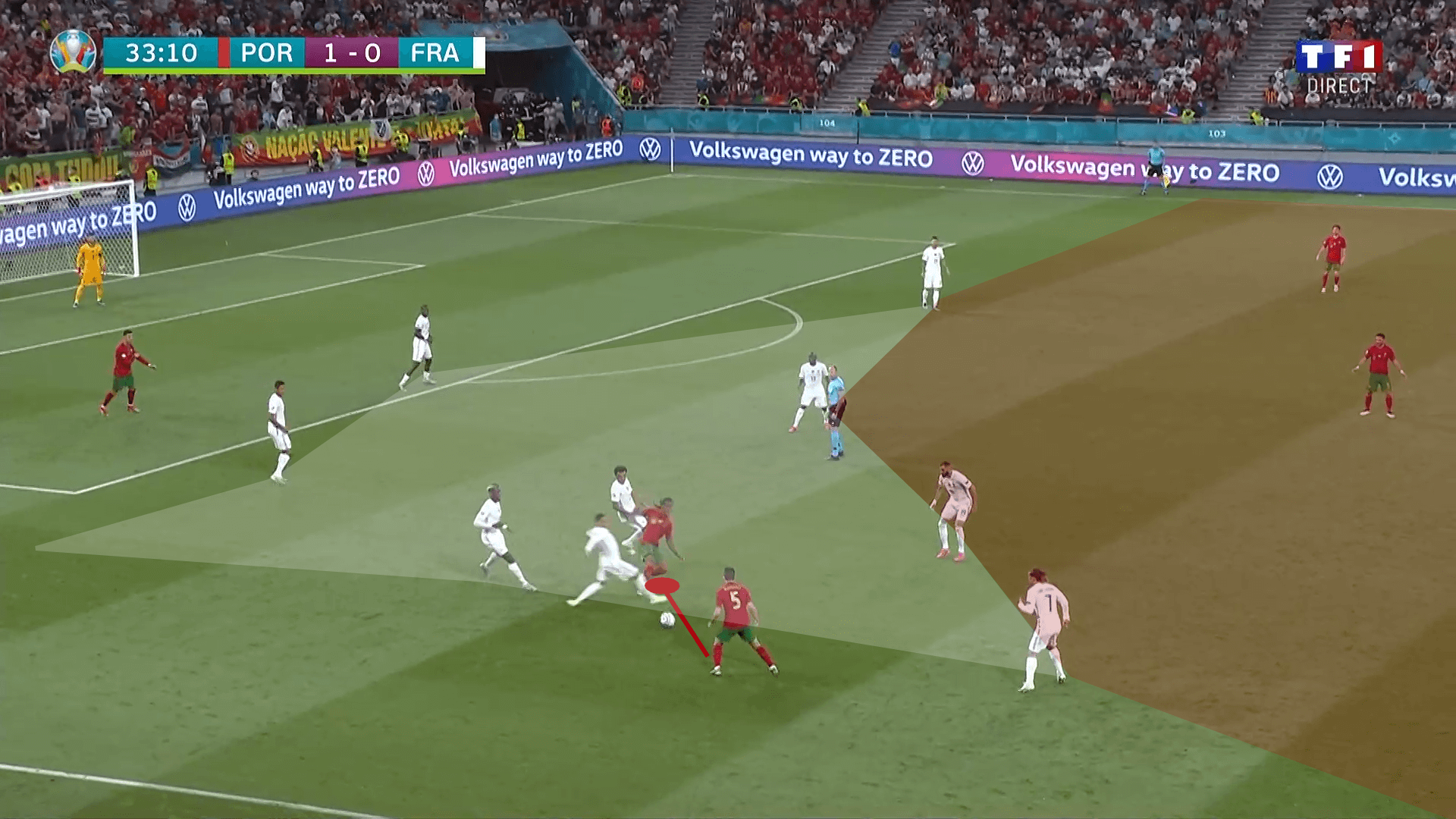
In the case of Moutinho, even though he was the most advanced of the three midfielders, he picked his starting positions beautifully. When Portugal needed help in the build-out, he dropped deep into the available pockets of space to help break the French press. As Portugal moved into the attacking third, he found a way to distance himself from Kanté and direct play higher up the pitch.
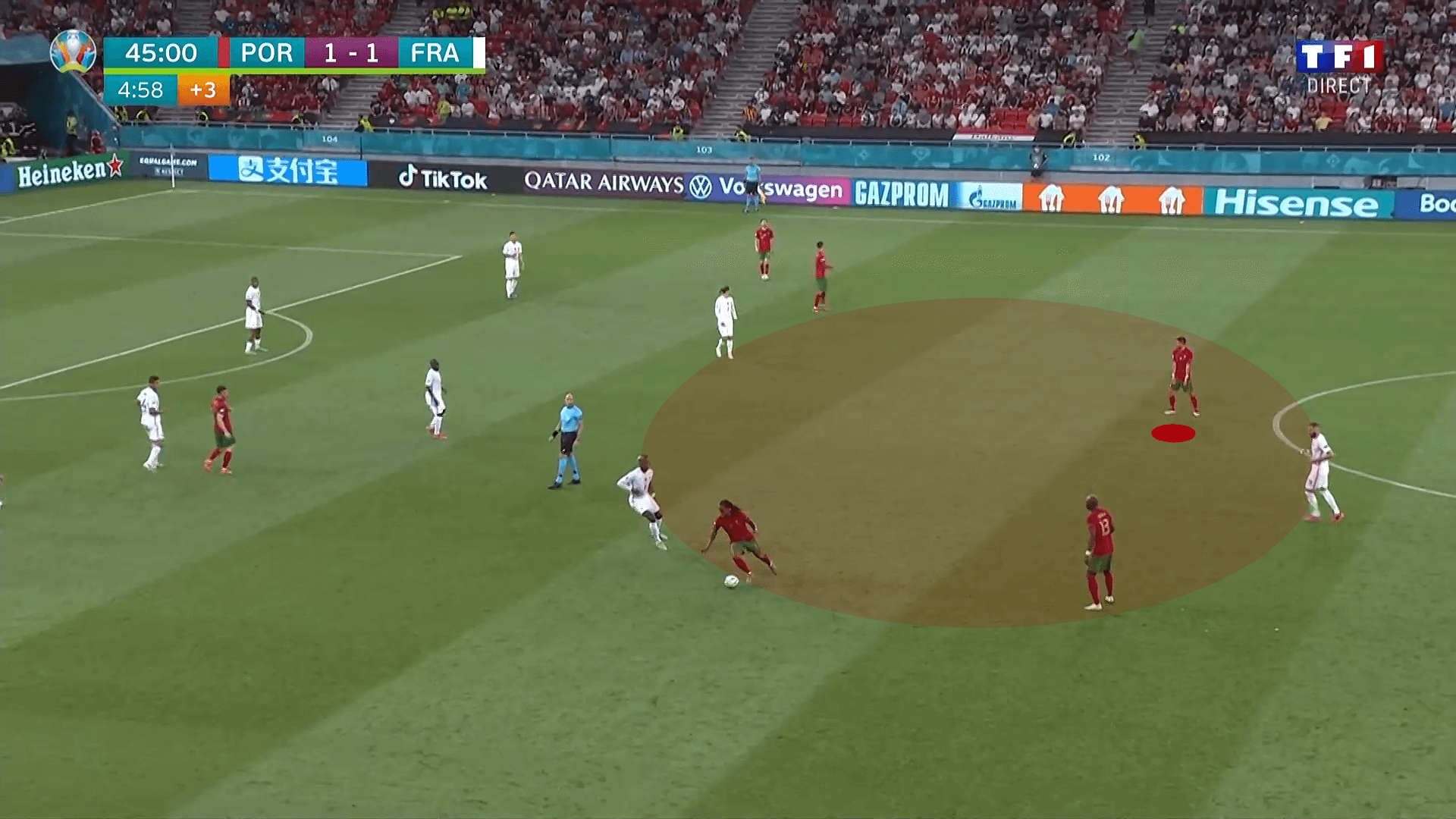
While Moutinho typically positioned himself outside of France’s press, as in the image above, he was active enough to throw off the French defence and serve as a midfield outlet. He even managed a couple of shots from the top of the box in the first half, showing that he used his positioning outside of the press to both look for his high targets and search for his own opportunities.
Pogba’s role was key for France
When France produced their moments of brilliance, they typically came from the boot of Pogba. Getting the ball to the Manchester United midfielder so he could lead the attack was the clear priority for the French. With the exception of a Griezmann pass, any ball played through or behind the Portuguese backline typically came from Pogba. Fortunately for the French, he was on his game in this one, punishing Portugal with several well-weighted passes with pinpoint accuracy.
France clearly wanted Pogba to set the team’s tempo, but their match tactics had to find a way to get him the ball with time and space to play forward. The solution was to position him as the deepest midfielder when France was in possession. Though the average position map below shows him as the most advanced midfielder, that was largely due to the defensive recoveries of Kanté and Tolisso. In open possessions, Pogba often situated himself near midfield, sitting between Ronaldo and the Portuguese midfielders.
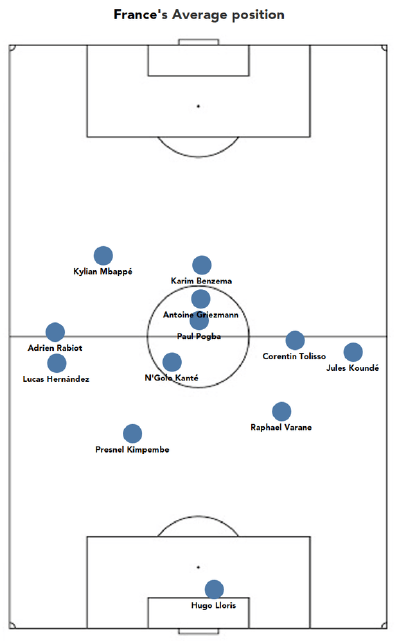
In the image below, the lines indicate positional groupings. The combination of Benzema, Mbappé and Griezmann are represented with the central triangle. In the two wings, we have the two outside-backs while Pogba, Kanté and Tolisso have taken up deeper positions in midfield. Pogba’s the right-most midfielder in this instance though he commonly situated himself in a central position while Kanté and Tolisso played a little bit higher to his left and right in open possessions.
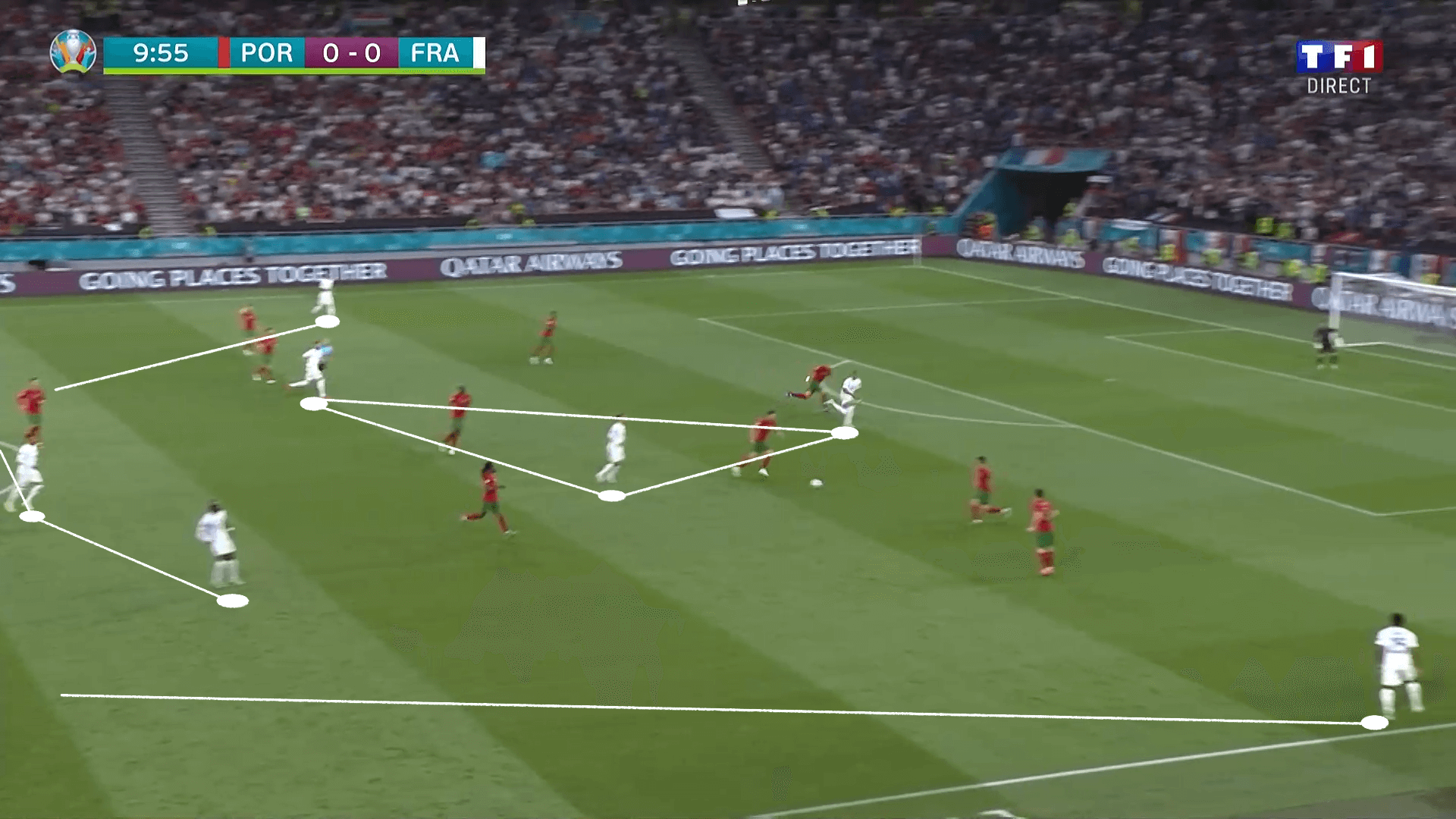
As Pogba received passes, Portugal made an effort to immediately pressure him, but they struggled with consistency. In the image below, we see Pogba using his starting positioning outside of the Portuguese press to play a through ball to Mbappé in the top two images, resulting in a shot with the Patrício save. In the second sequence, he plays the ball over the top of the Portuguese defence. This is where Mbappé drew enough contact from Semedo to hit the ground convincingly, resulting in France’s penalty kick. In the third sequence, he splits Guerreiro and Dias, playing the ball into the path of Benzema for the second French goal.
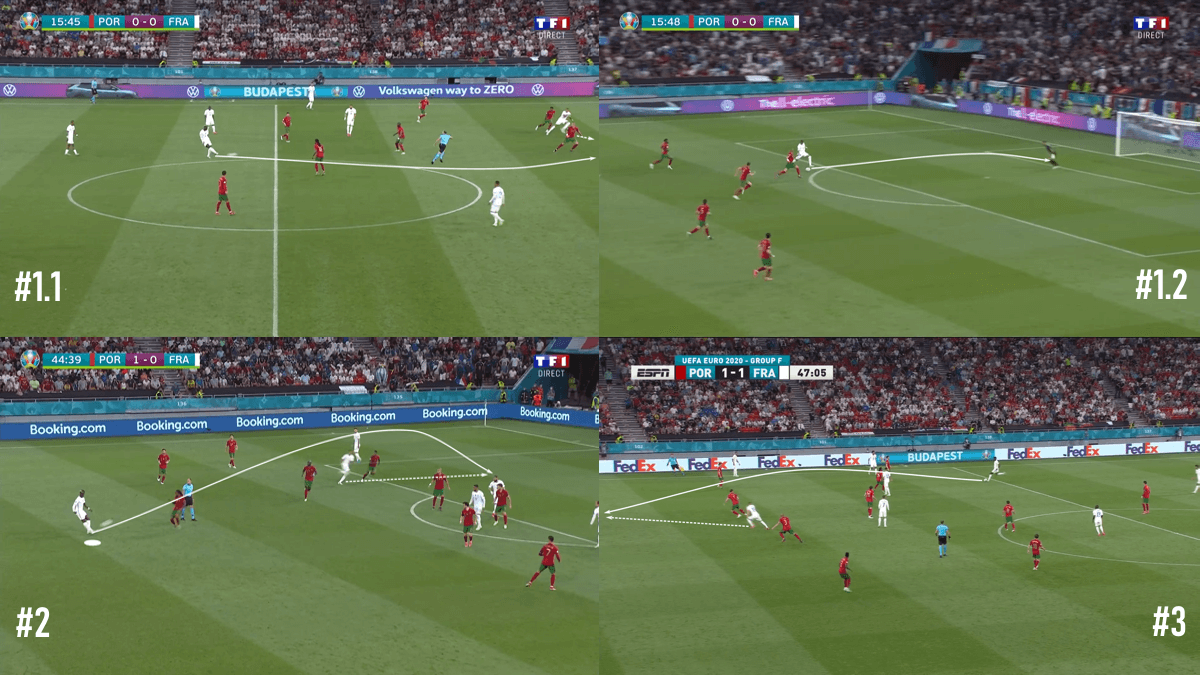
While it’s his passing that primarily victimized the Portuguese, he did look for his opportunities to press higher up the pitch. In the 68th minute, with nine Portuguese players within 22 metres of the goal, Pogba feinted around João Paulinha, a halftime sub for Danilo who was punched in the temple by Lloris, then had a crack on goal. It was a fantastic shot that found its way through the Portuguese defence and drew what’s likely to be the save of the tournament from Patrício. In fact, it was a double save by the recent Roma signing that preserved the draw.
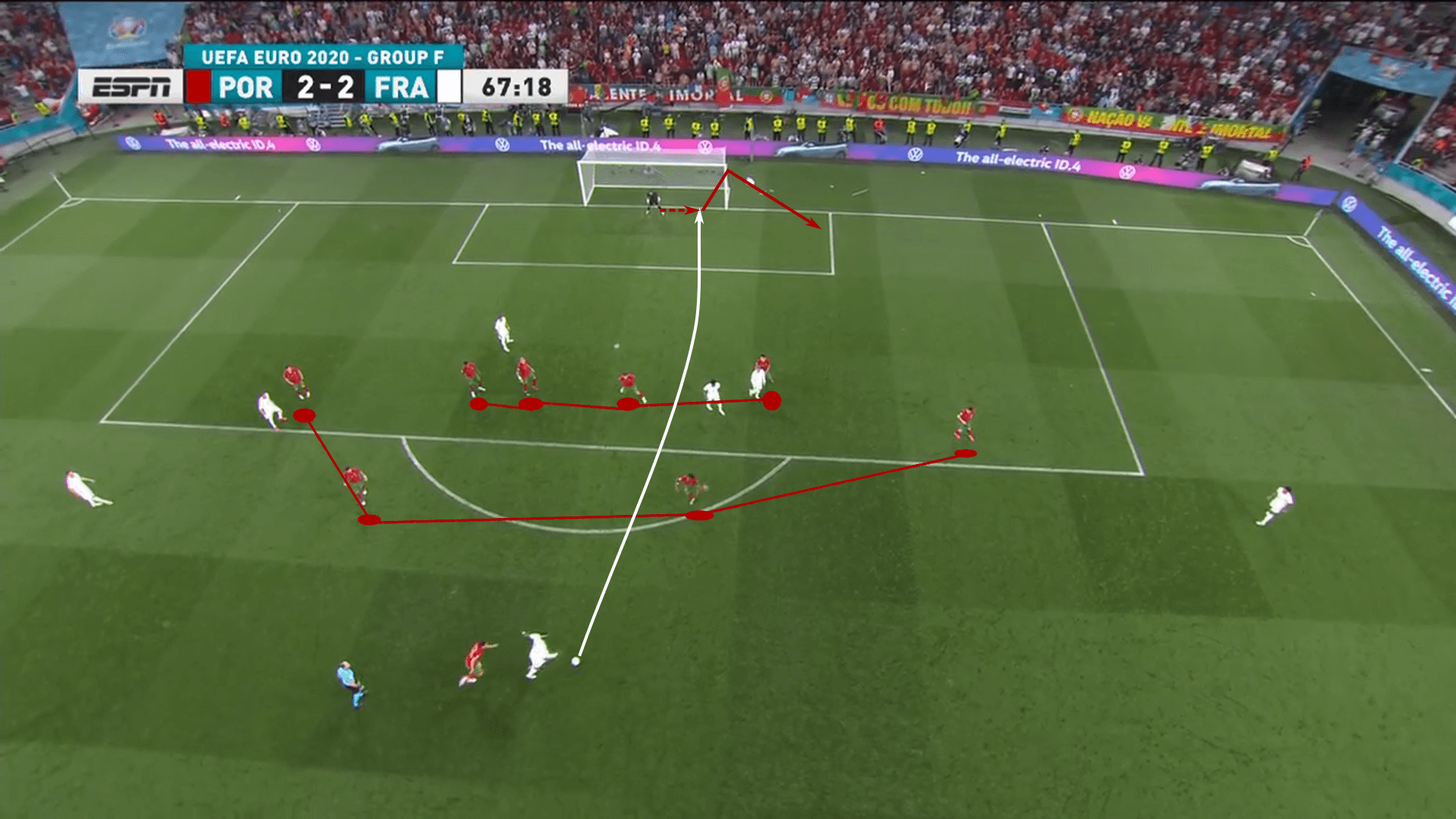
With all the talent France has at the top of their formation, plus the outside-backs and the pair of Kanté and Tolisso pushing higher up the pitch, Portugal found it difficult to cope with Pogba’s deep drops. His time in possession outside of the Portuguese press was a warning signal that the Portuguese backline was too slow to notice on many occasions. When Pogba received and had time to play forward, The French players knew it was time to make a run behind the Portuguese backline. Mbappé was the primary target. Semedo and Pepe adapted as the match went on, but the PSG superstar still managed to leave his mark on the game, even if the scoreline contribution was drawing a soft penalty.
2nd half adjustments produce chances
Both teams made halftime substitutions, but not for a change in tactics. Danilo and Hernandez picked up injuries in the first half, requiring substitutions. To make matters worse for France, Lucas Digne entered the match only to pick up an injury of his own, lasting just 6 minutes. With limited depth at outside-back, they called on Rabiot to fill the void.
For the first 15 to 20 minutes of the second half, there was very little tactical diversion from what we’ve covered in this analysis. However, as additional subs entered the field of play, each team made one last 10-minute burst in search of the winner. Kingsley Coman entered the match, joining Mbappé and Benzema up top while Griezmann dropped deeper into the midfield. The two outside-backs continued to push higher up the pitch, allowing France to pin the Portuguese deep in their half.
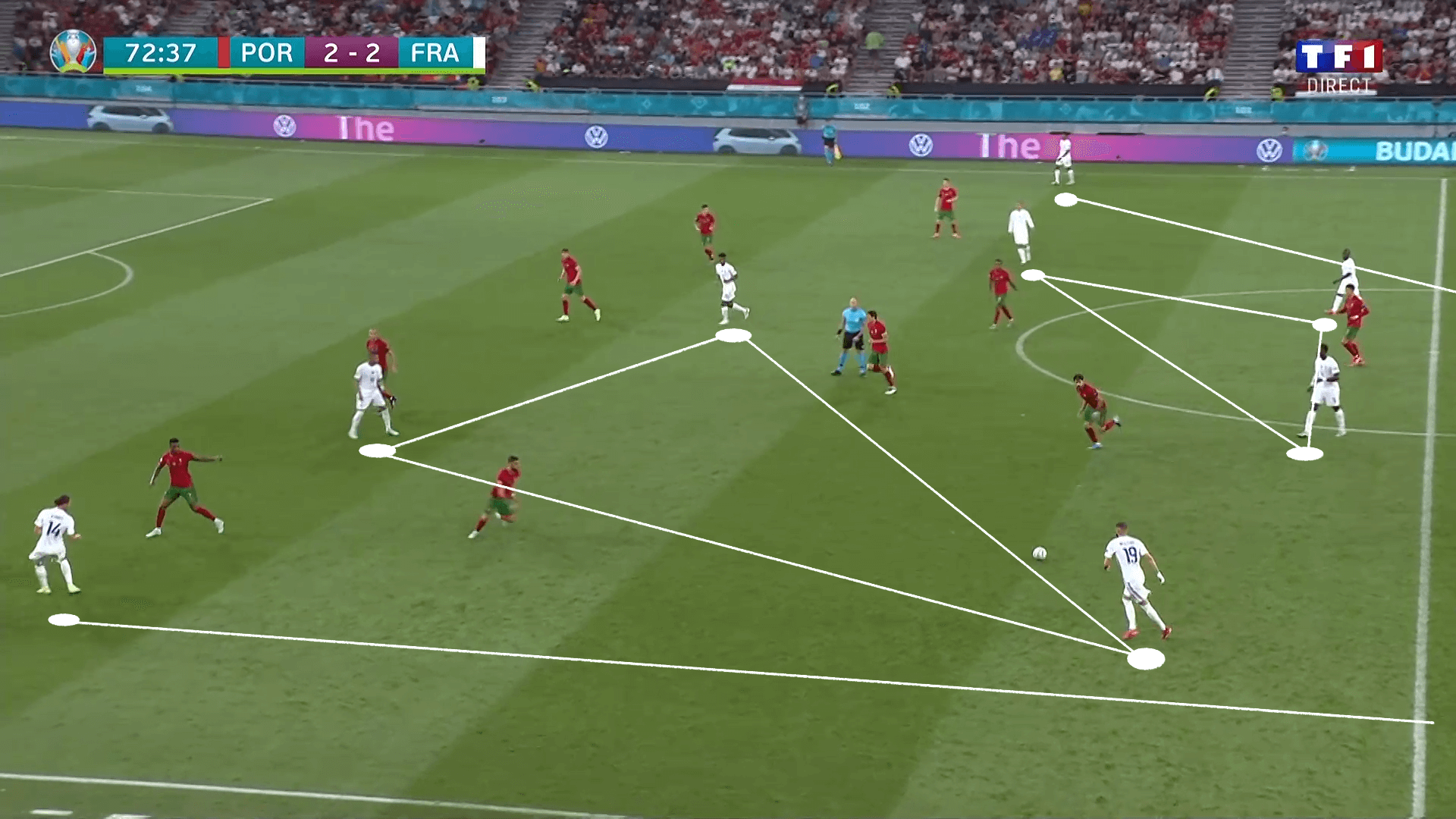
In the image above, video analysis shows it was the pace of Mbappé and Coleman in those high central positions that France wanted to utilise. With Griezmann in a deeper position on the right side of the pitch, Benzema often dropped into the left half space to act as a playmaker.
For Portugal, Bernardo made way for Fernandes, Diogo Dalot replaced the injured Semedo and Rúben Neves subbed on for his Wolves teammate Moutinho. When the subs entered the game, Portugal’s objective was to preserve the draw and secure their spot in the Round of 16. Neves played deeper than Moutinho and Dalot was more cautious in his attacking contributions, often remaining in a deeper position. When Portugal had the ball, Fernandes looked to offer an outlet in the wings and create from there.
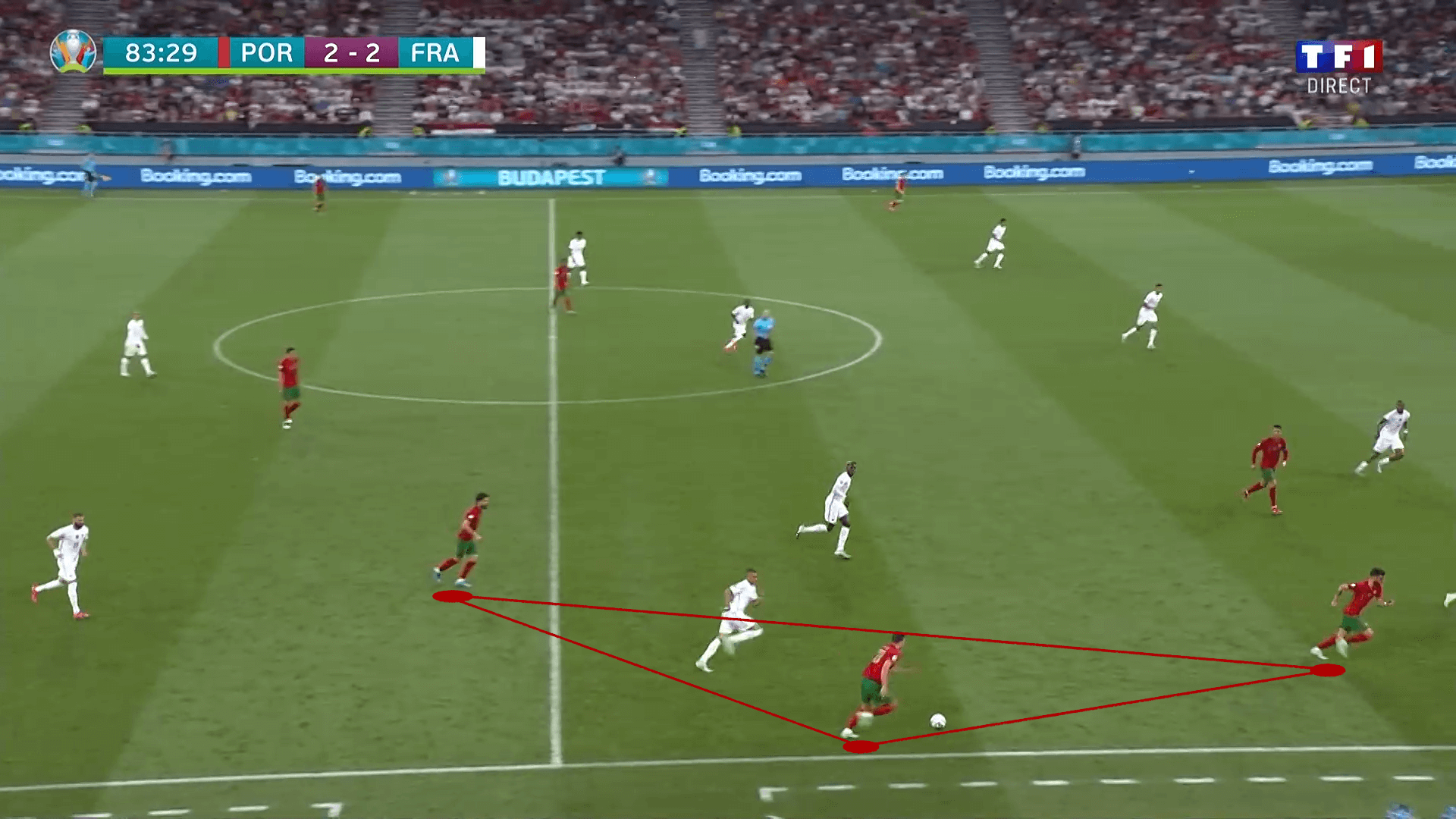
Though Fernandes typically pushed up the pitch when Portugal was in possession, he was often called to operate in a right midfield role, tracking the runs of Rabiot. Defensively, he and his Manchester United teammate Dalot operated in close proximity to each other. In many instances, Neves was the more advanced of the three, largely due to the fact that he had to push higher up the pitch to pressure Pogba, as seen in the image below.
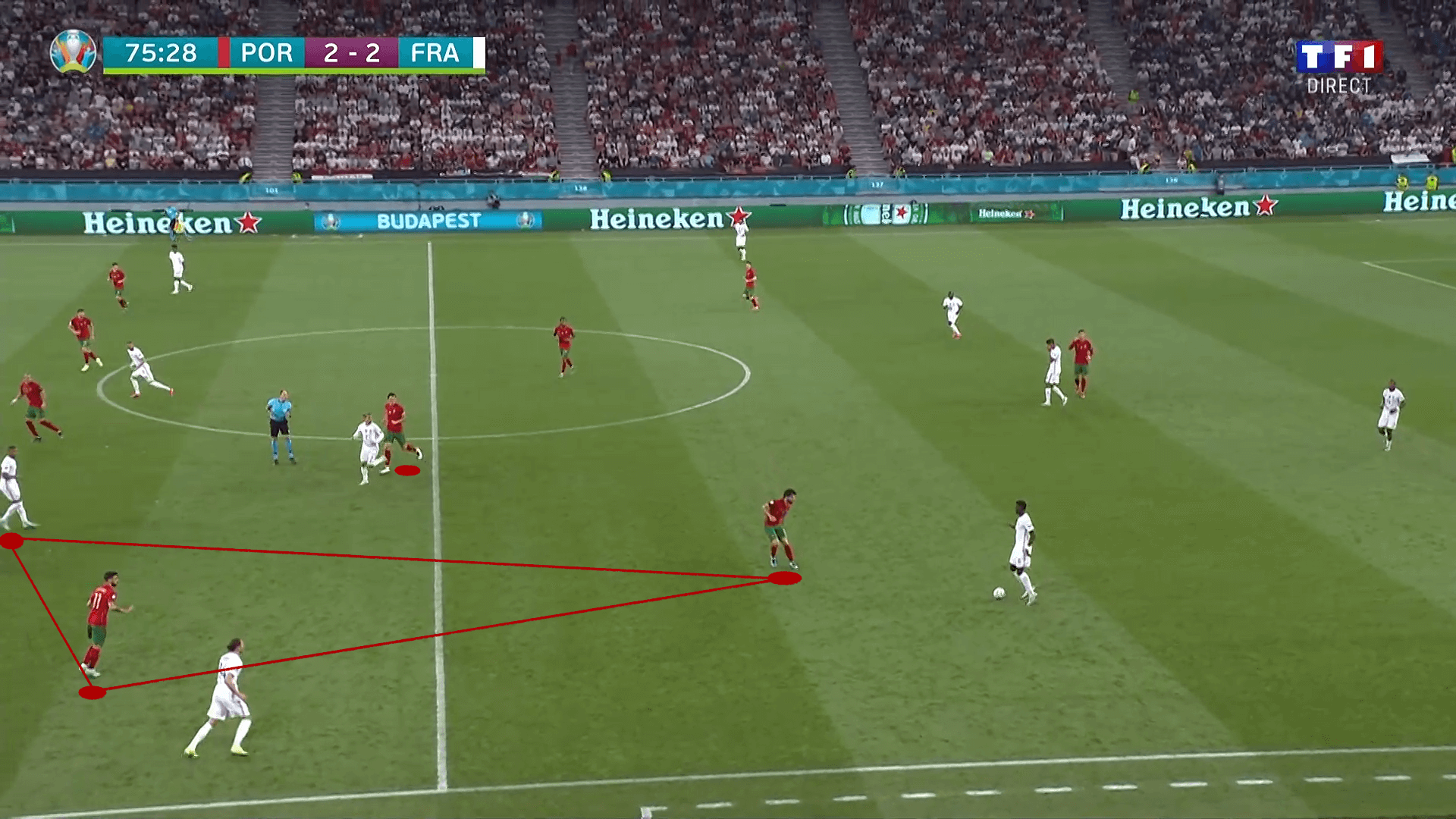
70th-minute substitutions produced a brief frenzy that saw France pin Portugal deep on numerous occasions, but, after that short burst, both teams seem content to scale back their attacking intentions and settle for the draw.
Conclusion
Through the final 20 minutes of the match were rather uneventful, the first 75, paired with the simultaneous drama of the Germany vs Hungary match, were highly entertaining. This game had a little bit of everything: goals, penalty kicks, controversial officiating and some brilliant individual displays. The fixture lived up to its expectations.
Above each of those entertainment features, it was the work of the midfielders that stood out most. I could write another article on the pressing structures of the two teams as they were brilliant throughout and made it difficult for either side to break lines in the build-out. The structure and individual brilliance to produce moments of magic are the reasons these two teams expect to make deep runs in the tournament.
On paper, France has the easier of the two tasks, facing a Switzerland side that laboured to a third-place finish while producing a negative goal differential.
For Portugal, they move from the marquee match of the group stage to the marquee match of the Round of 16. Having drawn 2-2 against the tournament favourites and defending world champions, they move on to face the number one ranked team in the world, Belgium. They’ve swapped the Group of Death for the Quadrant of Death. Though the Belgians are slight favourites, this promises to be an exceptional match with neither team showing fear of the other.
The knockout rounds are upon us. You could argue the four teams in the Group of Death have already played three knockout matches, either hindering them physically or preparing them psychologically. If both Portugal and France can make it through the next two games, we will get a rematch with even higher stakes.
Finally, we’d be remiss to leave Ronaldo out of this analysis. With his two goals against France, the Portugal legand drew level with Ali Daei for the most goals in international play. His tally of 109 goals in 178 games could see the current tournament goals leader move into sole possession of the record.





Comments